Visiting the Haven Colony in Brooklin is like traveling back in time to a community of seasonal cottages founded more than a century ago. You can imagine life with steamboats coming and going, families sailing, women decked out in fancy hats and ankle-length skirts, men dressed in the fashion of the day.
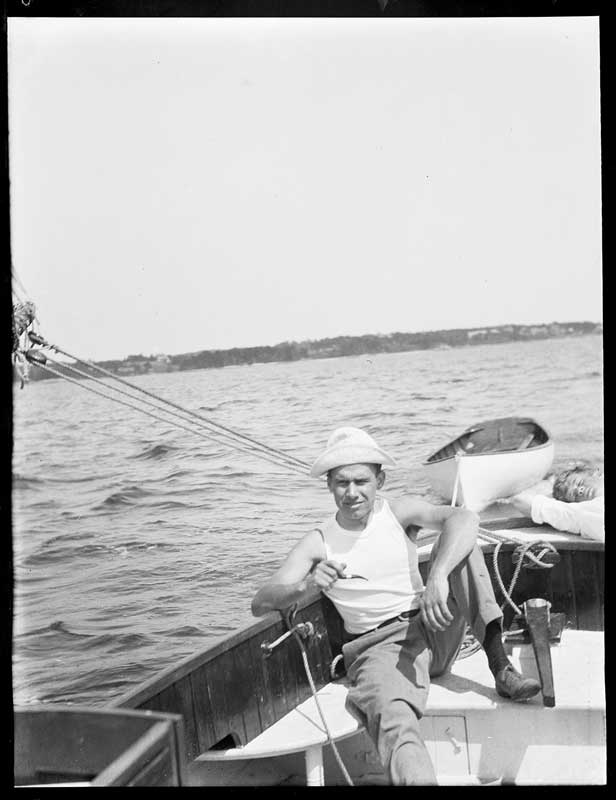 The pipe-smoking helmsman is none other than Parker “Pack” Dodge. He is guiding the gaff-rigged sloop Dixie and her tender off of Brooklin. 1910But now, people can do more than just imagine what life was like in the small tightly knit hamlet back in the day. The Penobscot Marine Museum has digitized hundreds of long-forgotten negatives of photos taken by longtime summer denizen Parker “Pack” Dodge between the early 1900s and the 1930s.
The pipe-smoking helmsman is none other than Parker “Pack” Dodge. He is guiding the gaff-rigged sloop Dixie and her tender off of Brooklin. 1910But now, people can do more than just imagine what life was like in the small tightly knit hamlet back in the day. The Penobscot Marine Museum has digitized hundreds of long-forgotten negatives of photos taken by longtime summer denizen Parker “Pack” Dodge between the early 1900s and the 1930s.
The museum has created a Parker “Pack” Dodge Collection page on its website and will populate it with about 300 of Dodge’s photos this summer, making them available to the public for viewing.
The negatives were donated to the museum by Pack Dodge’s grandson, John Dodge, who found them in a shoebox when cleaning out his parents’ house in Nebraska a couple of years ago after his mother died. The photos provide a glimpse into life a century and more ago on the shores and waters of Brooklin’s Center Harbor.
John Dodge and his cousin, Paul Gagliardi, approached the museum about a year ago to see if they’d be interested in the negatives. Gagliardi, who is Pack Dodge’s grandson on his mother’s side, and Dodge both still have cottages in Haven Colony.
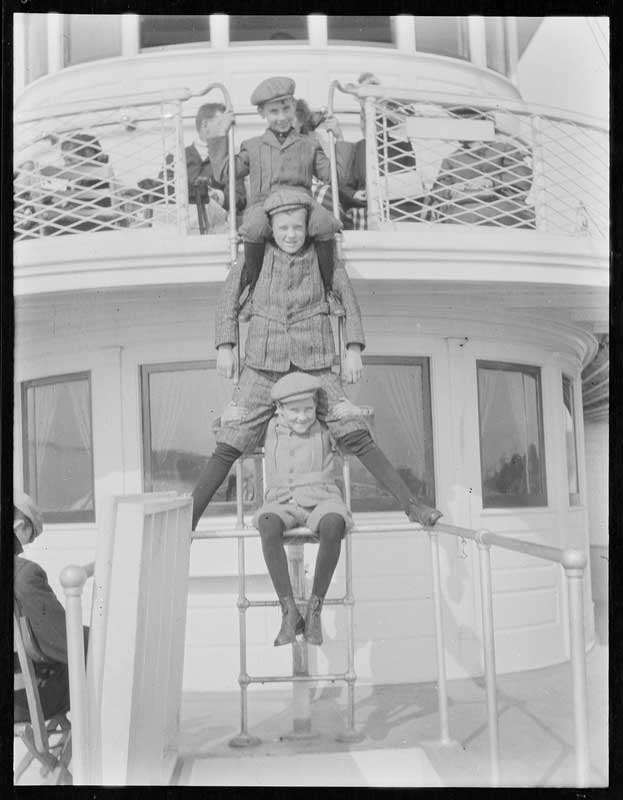 John Parson, Ken Parson, and Will Dodge are stacked up on the ladder of the coastal steamer JT Morse in 1905. The Morse was launched just two years earlier in 1903 by William McKie in East Boston for the Eastern Steamship Corp. She ran the Rockland to Bar Harbor route until 1933. Dodge decided to donate the negatives as a way to both preserve them and make them accessible to other families with cottages in Haven Colony, people in Brooklin, or simply anybody with an interest.
John Parson, Ken Parson, and Will Dodge are stacked up on the ladder of the coastal steamer JT Morse in 1905. The Morse was launched just two years earlier in 1903 by William McKie in East Boston for the Eastern Steamship Corp. She ran the Rockland to Bar Harbor route until 1933. Dodge decided to donate the negatives as a way to both preserve them and make them accessible to other families with cottages in Haven Colony, people in Brooklin, or simply anybody with an interest.
“Even if I wanted to make prints from them, it would not be easy to do,” said Dodge, who lives in Brunswick. “The Penobscot Marine Museum is digitizing them and they’ll be available to anyone who wants to see them. I was thrilled with that. It was the simplest way to make them available to all my cousins and other family members, but also other families from Brooklin who would have ancestors in these photographs.”
The Haven Colony is a tiny community of about 20 seasonal cottages located between Route 175 and the western end of Center Harbor. It is shielded by trees and has only three dirt roads; the main road, Steamboat Road, is so named because it led to the steamboat landing where summer visitors used to arrive by boat.
The colony was established in the late 1800s by Noah Tibbetts, who was born in Brooklin and moved as a young man to Washington, D.C., where he worked in the U.S. Patent Office for 48 years.
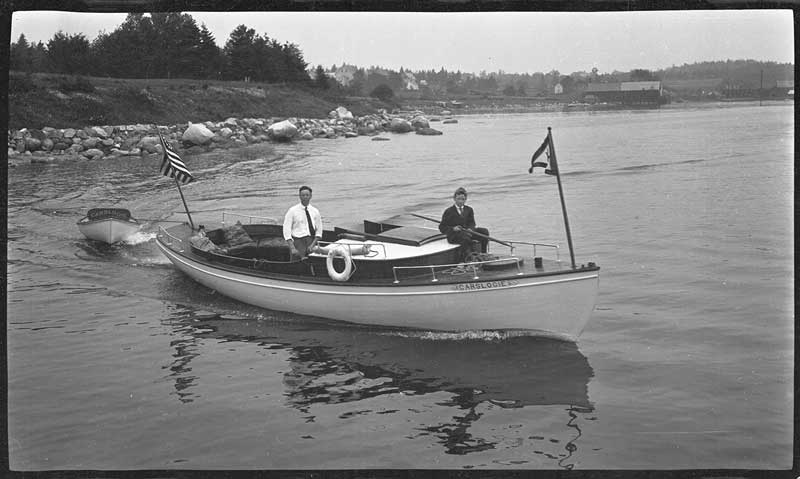 The lovely cabin launch Carslogie poses for the camera after making a tight turn near the shore of Center Harbor, towing her equally handsome tender. She was owned by the Clephanes, a prominent Washington family of Scots ancestry who had a cottage at Haven Colony. 1913
The lovely cabin launch Carslogie poses for the camera after making a tight turn near the shore of Center Harbor, towing her equally handsome tender. She was owned by the Clephanes, a prominent Washington family of Scots ancestry who had a cottage at Haven Colony. 1913
The colony started with a boarding house, where Tibbetts rented rooms for $5 to $7 a week. He then started building cottages and a dining hall, and eventually began selling lots. An early subdivision map calls the development Castle View Cottage Lots.
Visitors in those early years came mostly from Washington, D.C., and were an assortment of lawyers, judges, ministers, and teachers. Dodge and Gagliardi agree the only famous early Haven Colony resident was John Wesley Powell, a geologist and explorer who led the first government-sponsored expedition down the Colorado River through the Grand Canyon in 1869. Powell died in Haven Colony in 1902 and is buried at Arlington National Cemetery.
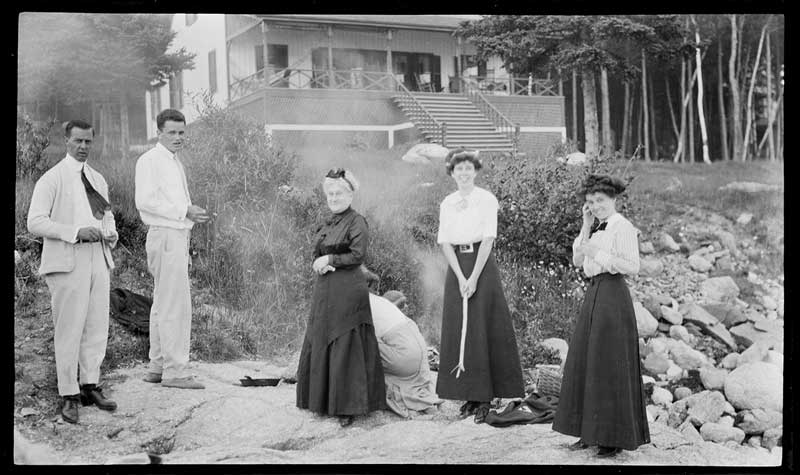 A group of Rusticators enjoys a shore dinner in front of the Haven cottage “Radnor.” 1911
A group of Rusticators enjoys a shore dinner in front of the Haven cottage “Radnor.” 1911
The uninsulated cottages weren’t suitable for year-round use, and most have stayed in the same families for generation after generation. Colony residents established the Center Harbor Yacht Club in 1912.
Pack Dodge, who died in 1972, was a patent attorney in Washington who enjoyed taking photos in the community and in Center Harbor, as well as in surrounding areas including Mount Desert Island and the Blue Hill Peninsula. He spent time in a Haven Colony house his father bought in 1902, when Pack was 17 or 18. In time, the house was passed down to Pack and his younger brother.
Based on the different sized negatives, it appears Pack Dodge took photos with at least four cameras through the years. The largest ones came from a postcard camera, which was popular at the beginning of the 20th century and produced postcard-size negatives, said Kevin Johnson, the photo archivist at the Penobscot Marine Museum. Dodge then turned to medium-format cameras, the type you hold at waist level and peer down into the viewfinder to take photos.
 The Northeast Harbor Yacht Club fleet is at the mouth of Center Harbor, with the Torrey Islands in the background. A grand steam yacht is anchored to watch the action. Circa 1910 His photos show a wide assortment of cottages, steamboats at the steamboat landing, landscapes, old canneries that once dotted the shore, and people sailing, canoeing, picnicking on islands, and simply relishing their time away from the heat of Washington. People came to Haven to relax and enjoy themselves, not to show off their credentials.
The Northeast Harbor Yacht Club fleet is at the mouth of Center Harbor, with the Torrey Islands in the background. A grand steam yacht is anchored to watch the action. Circa 1910 His photos show a wide assortment of cottages, steamboats at the steamboat landing, landscapes, old canneries that once dotted the shore, and people sailing, canoeing, picnicking on islands, and simply relishing their time away from the heat of Washington. People came to Haven to relax and enjoy themselves, not to show off their credentials.
At least two photos show Pack himself at the tiller of a sailboat. One shows him in a tank top, a sailor cap of some sort on his head, and a tobacco pipe in his hand; in the other he’s wearing a collared shirt with a tie, with the pipe hanging from the side from his mouth.
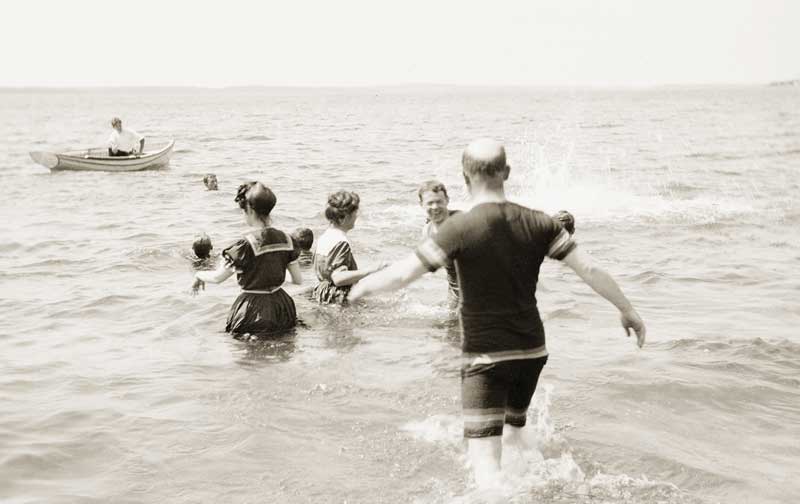 Sporting the latest styles of wool bathing costumes, these rusticators appear to be having a grand time in the chilly ocean water. Wool was the choice fabric for swimsuits due to its breathability and water-wicking characteristics. 1903
Sporting the latest styles of wool bathing costumes, these rusticators appear to be having a grand time in the chilly ocean water. Wool was the choice fabric for swimsuits due to its breathability and water-wicking characteristics. 1903
At the museum, Johnson has been busy digitizing the 800 donated negatives. When he’s done cataloging them, about 300 of them will be featured on the Parker Pack Dodge Collection page, in the website’s Collections section.
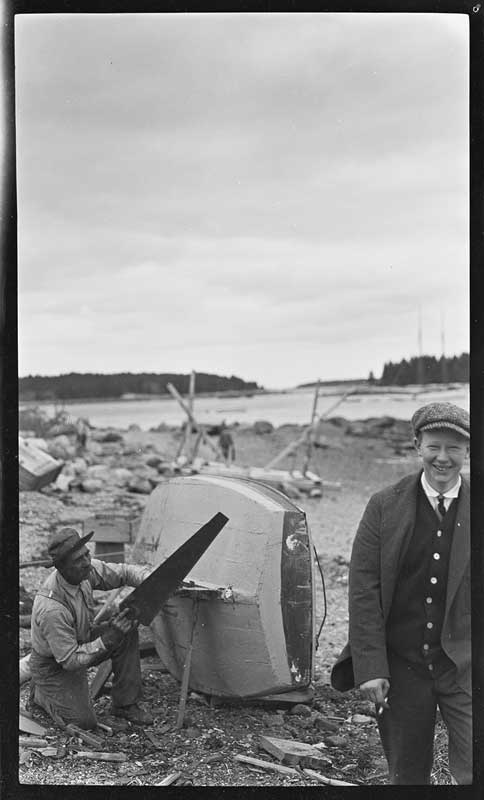 This Brutal Beast catboat is tipped on her side for a skeg repair on the northeast shore of Center Harbor, near the present day yacht club. The man with the saw is Noah Tibbetts, a local Brooklin man, who started the Haven Colony at Center Harbor. 1912The negatives came in paper sleeves with short descriptions, and the information will be reflected on the website. Besides showing what life was like in the community long ago, the photos also capture what was important to Pack Dodge.
This Brutal Beast catboat is tipped on her side for a skeg repair on the northeast shore of Center Harbor, near the present day yacht club. The man with the saw is Noah Tibbetts, a local Brooklin man, who started the Haven Colony at Center Harbor. 1912The negatives came in paper sleeves with short descriptions, and the information will be reflected on the website. Besides showing what life was like in the community long ago, the photos also capture what was important to Pack Dodge.
“What’s neat about this is it comes with its own point of view,” Johnson said. “If you’re there as a rusticator with your family and you have a new camera, your point of view is totally different. You’re capturing what is unique about the place to you, and you’re capturing your family’s adventures. It’s a whole specific point of view that’s unique. I like having these various points of view represented in our collections.”
While summer life in Haven Colony has changed over time, the feeling of timelessness remains. The special setting is one reason why so few houses there have changed hands through the years.
Gagliardi, who lives in Oakland, Maine, outside of Waterville, said Pack Dodge’s grandchildren have five homes there in Haven Colony. He’s happy that Pack Dodge’s photos on the Penobscot Marine Museum site allow others to see the colony in its early days.
“It’s hidden from view and there are so many descendants of the people who were there over 100 years ago,” he said. “If you walk down the Steamboat Road, it looks almost the same as it looked 100 years ago.”
✮
Clarke Canfield is a longtime journalist and author. He lives in South Portland with his wife, and enjoys a summer home in Brooksville.
To view the Parker “Pack” Dodge Haven Colony photos and other Penobscot Museum collections, visit penobscotmarinemuseum.org.






